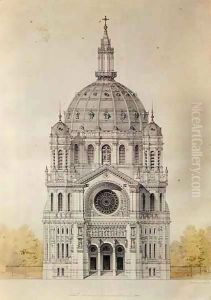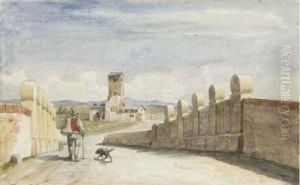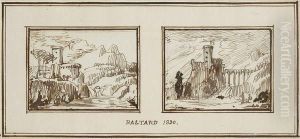Victor Baltard Paintings
Victor Baltard was a prominent French architect and engraver, born on June 19, 1805, in Paris, France. He was the son of architect Louis-Pierre Baltard, who provided his initial training and instilled in him a deep understanding of classical architecture and design. Victor later attended the École des Beaux-Arts in Paris, where he honed his skills and absorbed the prevailing neoclassical aesthetic that would influence much of his work.
In 1833, Baltard won the prestigious Prix de Rome for architecture, which allowed him to study at the French Academy in Rome, the Villa Medici, for five years. His time in Italy had a significant impact on his architectural style, as he was exposed to ancient Roman architecture as well as Renaissance and Baroque styles. Upon his return to France, Baltard embarked on a career that would see him become one of the most significant architects of his time, especially known for his work in iron and glass.
Perhaps Baltard's most famous contribution to architecture was the design of the Parisian market known as Les Halles, completed in the 1850s. This project showcased his innovative use of iron and glass, creating vast, open interiors that were flooded with natural light. The structure was a technical marvel of its time and became a symbol of modern architecture. Unfortunately, despite its architectural significance, Les Halles was demolished in 1971, and only one of the pavilions, the Pavillon Baltard, was relocated and preserved.
Beyond Les Halles, Baltard worked on various other projects, including the design of churches, such as the Saint-Augustin church in Paris, which also featured his characteristic ironwork. He held the position of the official architect of the city of Paris, and his work had a considerable influence on the urban landscape of the city during the Second Empire under Napoleon III.
Baltard's contributions to the field of architecture extended beyond his buildings. He was an educator who taught at the École des Beaux-Arts, influencing a generation of architects with his ideas and approach to design. His legacy also includes a collection of engravings that depicted architectural masterpieces from antiquity to the Renaissance, which were used for educational purposes and helped disseminate architectural knowledge.
Victor Baltard passed away on January 13, 1874, in Paris. While some of his architectural works have not survived, his influence on the architecture of the 19th century and his role in the development of modern urban spaces remain significant. His innovative use of new materials like iron and glass paved the way for future architectural developments, and his teachings continued to inspire architects long after his death.


